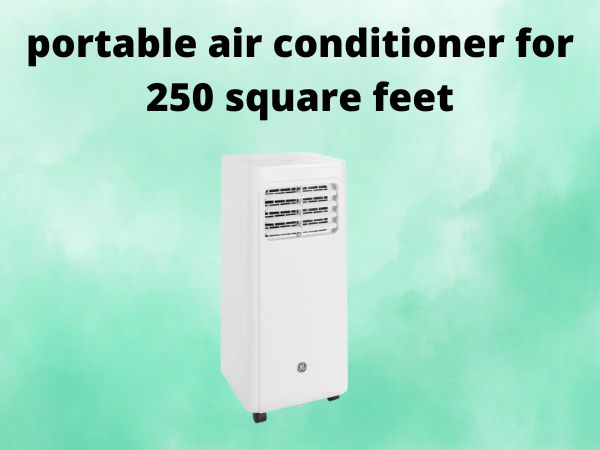5 Best Portable Air Conditioners for 250 Square Feet
When summer heat becomes unbearable, finding the right cooling solution for your 250-square-foot space can make all the difference between comfort and misery. Whether you’re dealing with a small apartment, bedroom, office, or studio, choosing the perfect portable air conditioner requires careful consideration of cooling power, energy efficiency, and practical features.
In this comprehensive guide, we’ll explore the top 5 air conditioning units specifically designed to handle 250 square feet of space effectively. From true portable units that you can wheel from room to room to efficient window units that pack serious cooling punch, we’ve analyzed real user experiences and technical specifications to bring you the most honest and detailed comparison available.
Table of Contents
Top 5 Portable Air Conditioners for 250 Square Feet
1. LG 6,000 BTU Portable Air Conditioner (LP0621WSR)
Key Features and Specifications
The LG LP0621WSR represents solid engineering from a trusted brand, delivering 6,000 BTUs of cooling power in a compact package. This 3-in-1 unit functions as an air conditioner, fan, and dehumidifier, making it versatile for year-round use.
Key specifications include 115V operation, 2.43-pint dehumidification capacity, and a 6.5 SEER rating. The unit measures 13.27″D x 17.32″W x 27.36″H and features an auto-swing air vent for even air distribution. Digital controls and remote operation add convenience, while the 24-hour timer and auto-restart function provide advanced control options.
Pros and Cons
Pros:
- Reliable LG build quality and brand reputation
- 3-in-1 functionality (cool/fan/dry modes)
- Auto-swing feature prevents hot spots
- No water drainage required in most conditions
- Effective cooling for spaces up to 400 square feet according to users
- Relatively quiet operation for sleeping
- Easy installation with included window kit
Cons:
- Louder than traditional window units
- Remote control lacks LED display for nighttime use
- Potential water leakage issues reported by some long-term users
- Limited low-speed fan options
- Requires periodic maintenance of drip pan in humid conditions
Best For
This unit excels for renters who need reliable cooling without permanent installation, users who want brand reliability over cutting-edge features, and those who appreciate the flexibility of 3-in-1 operation. It’s particularly well-suited for bedrooms where moderate noise levels are acceptable and the auto-swing feature helps distribute cool air evenly.
2. GE 9,000 BTU Portable 3-in-1 Air Conditioner
Key Features and Specifications
The GE 9,000 BTU unit brings serious cooling power to the portable category with its higher BTU rating and smart connectivity features. This WiFi-enabled unit allows remote control via smartphone apps, adding modern convenience to traditional cooling.
Specifications include 9,000 BTUs of cooling power, 50 dB noise level, and auto-evaporation technology that eliminates most water drainage concerns. The unit features easy-roll casters, LED digital controls, and includes a comprehensive window installation kit. Smart features include app control, voice assistant compatibility, and energy monitoring capabilities.
Pros and Cons
Pros:
- High cooling capacity for challenging spaces
- WiFi connectivity and smart home integration
- Auto-evaporation eliminates drainage hassles
- Professional-grade build quality
- Easy installation with comprehensive kit
- Good value for the cooling power provided
- Effective for larger or poorly insulated spaces
Cons:
- Higher power consumption due to increased BTU rating
- Single exhaust hose design reduces efficiency
- Heavier and bulkier than lower-BTU alternatives
- Plastic components may require reinforcement
- Limited portability due to size and weight
- May be overkill for well-insulated smaller spaces
Best For
This unit is ideal for challenging cooling situations like poorly insulated spaces, rooms with high heat loads, or areas where traditional window units won’t work. The smart features make it perfect for tech-savvy users who want remote control capabilities, while the higher BTU rating handles demanding cooling needs that smaller units can’t address.
3. LG 6,000 BTU Window Air Conditioner (LW6017R)
Key Features and Specifications
While technically a window unit rather than truly portable, the LG LW6017R earns its place here due to its easy installation and removal capabilities. This unit delivers efficient cooling with an impressive 11.5 SEER rating and ultra-quiet operation at just 52 dB.
The unit features 6,000 BTUs of cooling power, 1.8-pint dehumidification capacity, and 3 cooling speeds plus fan modes. Digital controls, remote operation, and 2-way air deflection provide excellent user control. The compact design measures 14.38″D x 17.31″W x 11.13″H, making it suitable for standard window installations.
Pros and Cons
Pros:
- Exceptional energy efficiency with 11.5 SEER rating
- Ultra-quiet operation ideal for bedrooms
- Long-term reliability proven by user experiences
- Excellent cooling performance for the BTU rating
- Cost-effective operation with low electricity consumption
- Easy seasonal installation and removal
- Excellent build quality typical of LG products
Cons:
- Requires suitable window for installation
- Not truly portable between rooms
- Installation requires some DIY skills
- Limited to cooling single rooms effectively
- Seasonal storage considerations
- May require additional window sealing for efficiency
Best For
Perfect for users who prioritize energy efficiency and quiet operation over true portability. This unit excels in bedrooms, home offices, or any space where consistent cooling and low operating costs matter more than the ability to move the unit frequently. It’s also ideal for users comfortable with basic window installation who want maximum cooling efficiency.
4. TOSOT 9,000 BTU Aovia Series Portable AC
Key Features and Specifications
The TOSOT Aovia series attempts to balance high cooling power with easy portability, offering 9,000 BTUs in a relatively compact design. This 3-in-1 unit emphasizes simplified installation and auto-evaporation technology for low-maintenance operation.
Key specifications include 5,200 BTU under 2017 DOE standards, 2.1 pints per hour dehumidification capacity, and 51 dB noise level. The unit measures 11.1″D x 12″W x 27.2″H with a 59-pound weight. Features include LED control panel, remote control with 20-foot range, and quick-adjust window installation system.
Pros and Cons
Pros:
- Compact footprint despite high BTU rating
- Simplified installation process
- Auto-evaporation reduces maintenance
- Attractive, modern design
- Good cooling performance in dry climates
- Competitive pricing for the BTU rating
- Multiple operating modes for versatility
Cons:
- Inconsistent cooling performance reported by users
- Temperature sensor causes frequent cycling that confuses users
- Build quality concerns with some components
- May struggle in high-humidity environments
- Customer service and warranty support issues
- Compressor protection delays can be frustrating
- Performance varies significantly with environmental conditions
Best For
This unit works best for users in dry climates who need higher BTU capacity but want a smaller footprint. It’s suitable for those who prioritize modern design and don’t mind learning the unit’s operating quirks. However, it may not be the best choice for humid environments or users who need consistent, predictable operation.
5. BLACK+DECKER 6,000 BTU Window Air Conditioner
Key Features and Specifications
The BLACK+DECKER BD06WT6 focuses on delivering solid cooling performance at an affordable price point. This window unit incorporates modern efficiency features while maintaining straightforward operation that appeals to users who want reliability without complexity.
Specifications include 6,000 BTUs of cooling power, 11 SEER rating, and eco-friendly R32 refrigerant. The unit measures 13.18″D x 15.98″W x 12.05″H and features full-function remote control, sleep mode, energy saver settings, and 24-hour programmable timer. Installation accommodates standard double-hung windows from 23″ to 36″ wide.
Pros and Cons
Pros:
- Excellent value for money
- Improved energy efficiency over older units
- Eco-friendly R32 refrigerant
- Comprehensive remote control functionality
- Easy installation with standard window kits
- Good cooling performance for the price point
- Reliable operation with minimal maintenance needs
Cons:
- Limited to window installation only
- Basic build quality reflects budget pricing
- Remote requires separate battery purchase
- May require additional sealing for optimal efficiency
- Limited advanced features compared to premium models
- Not suitable for non-standard window types
Best For
Ideal for budget-conscious users who need reliable cooling without premium features. This unit works well for renters who plan to install and remove seasonally, students in dorm rooms or apartments, or anyone who values straightforward operation over advanced functionality. It’s particularly suitable for standard window installations where ease of use matters more than cutting-edge features.
Why Choose a Portable Air Conditioner for Small Spaces?
Have you ever wondered why more people are ditching traditional window units for portable alternatives? The answer lies in flexibility and convenience. Portable air conditioners offer unique advantages that make them particularly appealing for modern living situations.

Unlike permanent installations, portable units give you the freedom to cool exactly where you need it most. Whether you’re renting and can’t modify windows, dealing with unusual window shapes, or simply want the ability to move cooling power between rooms, portable ACs provide solutions that traditional units simply can’t match.
The beauty of focusing on 250 square feet is that this represents the sweet spot for many living situations. It’s large enough to cover most bedrooms, small living rooms, or office spaces, yet small enough that you won’t need industrial-strength cooling that drives up electricity bills.
What to Look for When Buying a Portable AC for 250 Sq Ft
BTU Requirements for 250 Square Feet
Understanding BTU (British Thermal Units) is crucial for selecting the right unit. For 250 square feet, you’ll typically need between 6,000 and 9,000 BTUs, depending on several factors including ceiling height, insulation quality, sun exposure, and heat-generating appliances.
The general rule of thumb suggests 20-25 BTUs per square foot, which puts 250 square feet in the 5,000-6,250 BTU range. However, real-world conditions often demand more cooling power. Factors like poor insulation, large windows facing south, or multiple electronics can push your needs toward the 8,000-9,000 BTU range.
Energy Efficiency Considerations
Energy efficiency isn’t just about saving money—it’s about responsible cooling that doesn’t strain electrical systems or the environment. Look for units with high SEER (Seasonal Energy Efficiency Ratio) ratings and Energy Star certifications when available.
Modern portable ACs incorporate features like programmable timers, sleep modes, and smart temperature sensors that help optimize energy consumption. Some units even include eco-friendly refrigerants that reduce environmental impact while maintaining cooling performance.
Noise Levels and Operation
Nobody wants to choose between staying cool and getting sleep. Noise levels, measured in decibels (dB), vary significantly between models. Units operating at 50-55 dB are generally considered acceptable for bedroom use, while anything above 60 dB might prove disruptive.
Consider when and where you’ll use your unit most. If it’s primarily for nighttime bedroom cooling, prioritize quieter operation even if it means slightly less cooling power. For daytime office use, you might accept higher noise levels for better cooling performance.
Installation and Portability Features
True portability means more than just wheels on the bottom. Look for units with sturdy casters that work on both carpet and hard floors, manageable weight (though most will still require two people for stairs), and flexible exhaust hose systems that adapt to different window types.
Installation complexity varies dramatically between models. Some require minimal setup with simple window kits, while others might need additional sealing or modifications for optimal performance
Comparison Chart: At a Glance
| Model | BTU | Type | SEER | Noise Level | Price Range | Best Feature |
| LG LP0621WSR | 6,000 | Portable | 6.5 | Moderate | Mid-range | Brand reliability |
| GE 9,000 BTU | 9,000 | Portable | 2.6 | 50 dB | Higher | Smart connectivity |
| LG LW6017R | 6,000 | Window | 11.5 | 52 dB | Mid-range | Energy efficiency |
| TOSOT Aovia | 9,000 | Portable | 2.6 | 51 dB | Budget | Compact design |
| BLACK+DECKER | 6,000 | Window | 11 | Variable | Budget | Value for money |
Installation Tips for Maximum Efficiency
Proper installation can mean the difference between adequate cooling and exceptional performance. For portable units, ensure the exhaust hose is as short and straight as possible—every bend and extra foot of hose reduces efficiency. Seal gaps around the window kit meticulously using foam strips, caulk, or weatherstripping.
Window units require careful attention to support and sealing. Use L-brackets or support braces for heavier units, and don’t forget to angle the unit slightly outward for proper drainage. Poor installation can reduce efficiency by 20-30%, turning a properly sized unit into an inadequate one.
Consider your room’s layout when positioning portable units. Place them where the cool air can circulate freely, away from heat sources like lamps or electronics, and ensure adequate clearance around air intake and exhaust areas.
Maintenance and Care Guidelines
Regular maintenance extends unit life and maintains efficiency. Clean or replace filters monthly during heavy use periods—dirty filters can reduce efficiency by up to 15%. For portable units, check and clean the exhaust hose connection points seasonally.
Window units benefit from annual deep cleaning of the evaporator and condenser coils. Use a soft brush and gentle cleaners to remove built-up dirt and debris. Check drain holes and clear any blockages that could cause water backup.
Store seasonal units properly during off-months. Clean thoroughly, ensure complete drying, and store in a controlled environment when possible. Cover units to prevent dust accumulation and pest intrusion.
Energy Saving Tips
Maximize efficiency through smart usage habits. Set thermostats to 78°F or higher when home, and use programmable timers to avoid cooling empty spaces. Ceiling fans can make you feel 4-5 degrees cooler, allowing higher thermostat settings without sacrificing comfort.
Improve your space’s cooling efficiency through simple upgrades. Add blackout curtains to reduce solar heat gain, seal air leaks around windows and doors, and use weather stripping to prevent conditioned air from escaping. These improvements can reduce cooling loads by 10-20%.
Consider thermal mass strategies—close blinds during hot days to prevent heat buildup, and use cross-ventilation during cooler evening hours to purge accumulated heat. These techniques reduce the workload on your AC unit and lower operating costs.
Frequently Asked Questions
How much electricity does a 6,000 BTU air conditioner use per day? A 6,000 BTU air conditioner typically uses 5-7 kWh per day when running continuously, costing approximately $0.60-$1.00 daily based on average electricity rates. Actual usage varies significantly based on thermostat settings, room insulation, and outdoor temperatures.
Can I use a portable air conditioner without a window? Portable air conditioners require an exhaust method to remove hot air from the conditioned space. While windows are most common, you can also vent through doors, walls, or drop ceilings with appropriate adapters and modifications. However, some form of exhaust is absolutely necessary for proper operation.
What’s the difference between BTU and SACC ratings? BTU measures the unit’s theoretical cooling capacity, while SACC (Seasonally Adjusted Cooling Capacity) represents real-world cooling performance accounting for heat infiltration through exhaust hoses. SACC ratings are typically 30-40% lower than BTU ratings for portable units, providing more accurate performance expectations.
How often should I clean my portable air conditioner filter? Clean or replace filters every 2-4 weeks during heavy use periods, or when the filter appears visibly dirty. Some units include filter indicators that alert you when cleaning is needed. Clean filters ensure optimal airflow and cooling efficiency while extending unit life.
Is it more efficient to run my air conditioner continuously or turn it on and off? For most modern units, maintaining consistent temperatures through continuous operation at higher settings (78-80°F) is more efficient than frequently cycling on and off. However, programmable timers and smart thermostats can optimize this balance automatically, reducing energy consumption while maintaining comfort.
Conclusion
Choosing the right air conditioner for your 250-square-foot space doesn’t have to be overwhelming. Each unit in our top 5 serves different needs and priorities, from the reliable LG portable units to the energy-efficient window options and smart-enabled GE model.
For most users, the LG LP0621WSR offers the best balance of reliability, features, and cooling performance. If you prioritize energy efficiency and quiet operation, the LG window unit LW6017R delivers exceptional value. Those needing maximum cooling power should consider the GE 9,000 BTU model, while budget-conscious buyers will appreciate the BLACK+DECKER unit’s straightforward value.
Remember that the best air conditioner is one that matches your specific situation—consider your space’s characteristics, your usage patterns, and your long-term needs. With proper selection and installation, any of these units can transform your 250-square-foot space into a comfortable retreat from summer heat.
The investment in quality cooling pays dividends in comfort, productivity, and peace of mind. Take time to evaluate your specific needs, and don’t hesitate to invest in proper installation and maintenance to get the most from your chosen unit.




